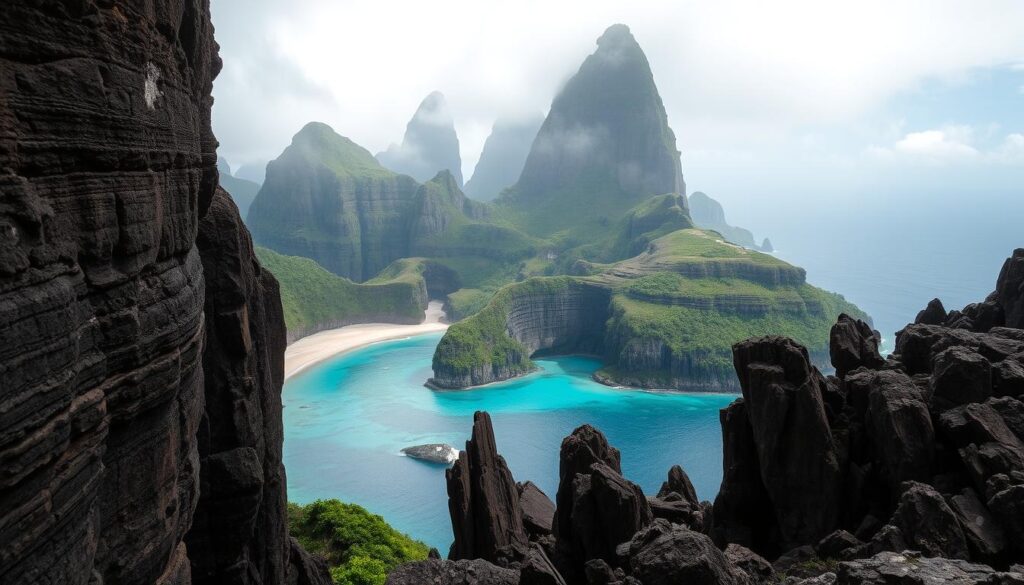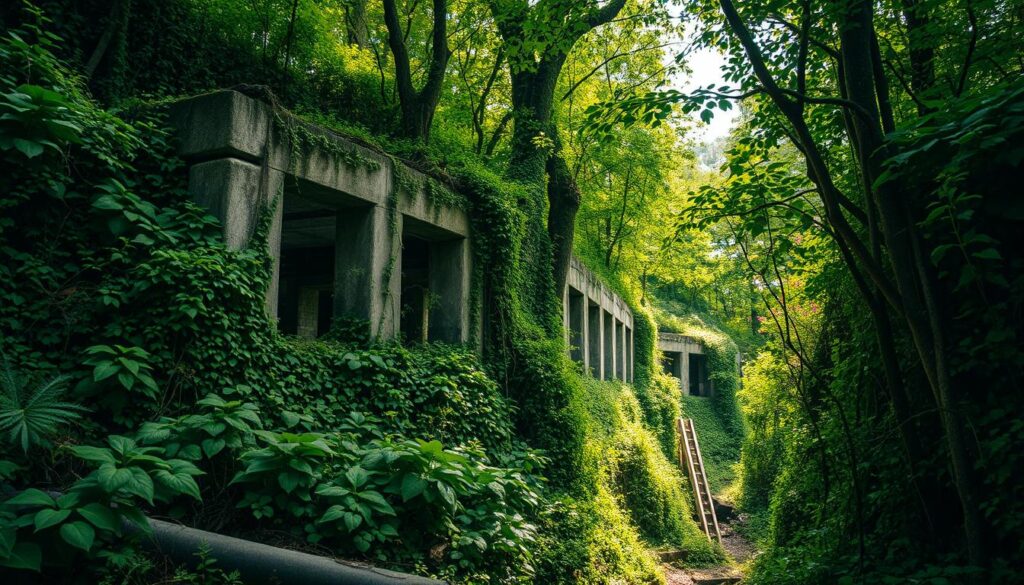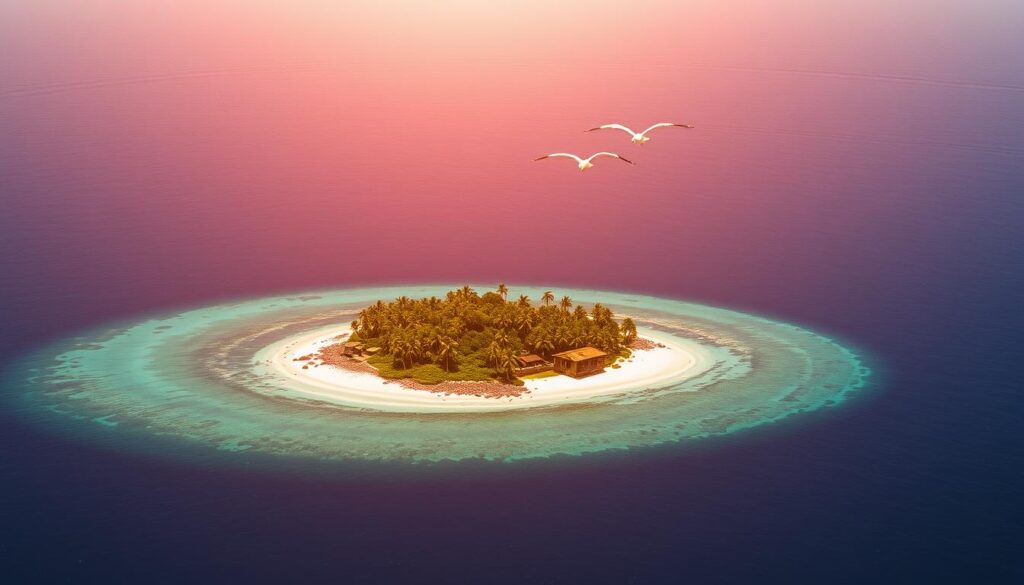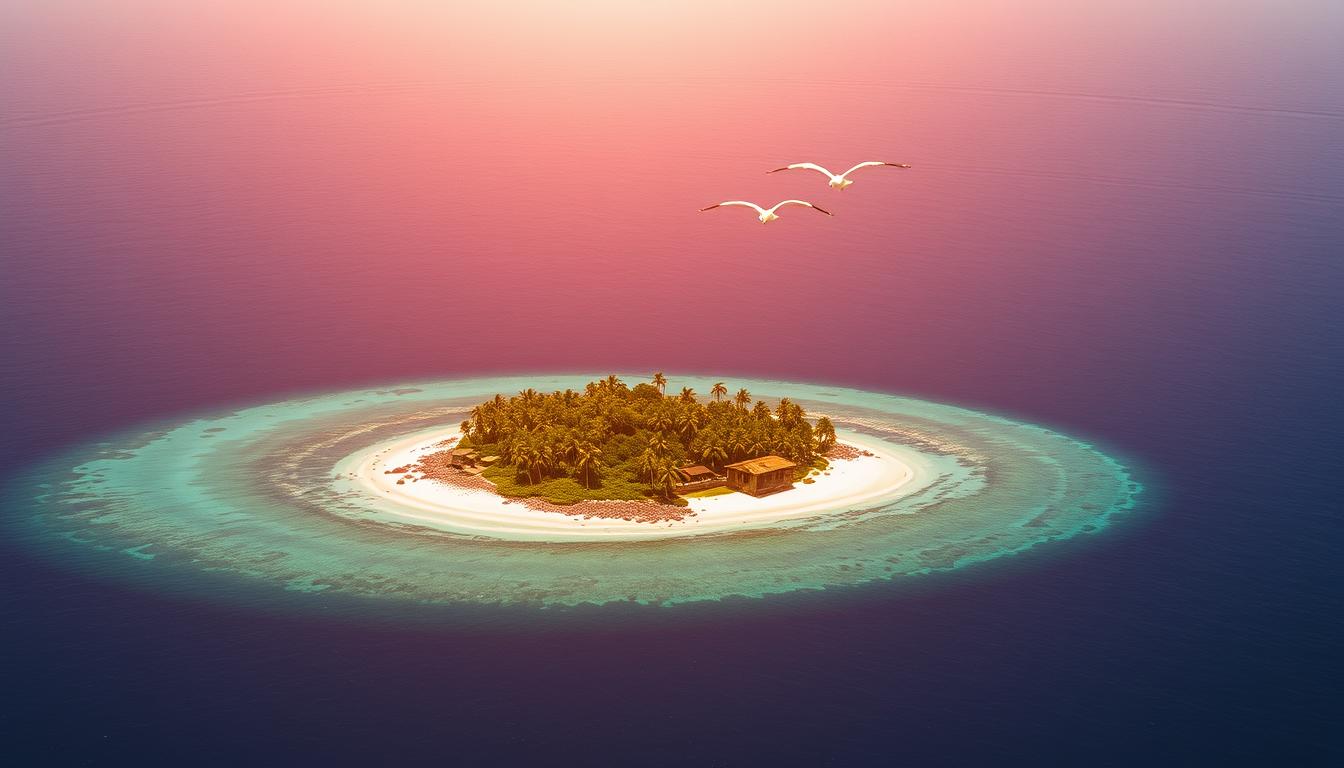Imagine a place where the air is crisp and the waters are clear. The land is untouched by humans. These remote islands, known as mysterious islands, have long fascinated people. They spark our curiosity and sense of adventure.
From the vast oceans to distant shores, these islands are a mystery. They wait for us to explore them.

The idea of mysterious islands has captured many imaginations. These islands, found all over the world, show us a world untouched by humans. As we explore these islands, we uncover their secrets and stories.
Key Takeaways
- Remote islands are scattered across the globe, waiting to be explored
- Mysterious islands have long fascinated people around the world
- Uninhabited islands offer a glimpse into a world untouched by human civilization
- These islands are often referred to as mysterious islands due to their inaccessibility
- Exploring remote islands can be a thrilling adventure, but also comes with challenges
- Understanding the allure of mysterious islands can spark our sense of curiosity and adventure
The Allure of Uninhabited Islands Around the Globe
Exploring islands has always captivated many. Untouched territories show us unspoiled beauty. These places are full of unique ecosystems and offer a chance to discover new things. Exploring such remote spots is both exciting and challenging.
Some islands are empty because of harsh weather or lack of resources. Others were once home to people but are now
Naturally uninhabited islands are found in far-off archipelagos. These places are too tough for humans to live in. Abandoned islands, on the other hand, have signs of past human life. Knowing the difference helps us understand these islands’ history and current state.
The charm of island exploration and untouched territories is clear. Many adventurers and scientists are drawn to them. By exploring these islands, we learn more about nature and our role in it. We also uncover the secrets of abandoned islands and their stories.
Most Remote Mysterious Islands No One Lives On
Remote islands have always captured our imagination. Their untouched landscapes and unexplored territories are a world untouched by humans. Visiting these places is an exciting way to disconnect and reconnect with nature.
In the Pacific and Arctic oceans, you’ll find some of the most remote islands. They boast unique features like volcanic landscapes and coral reefs. For instance, Tristan da Cunha in the South Atlantic is famous for its active volcano and rugged terrain.
Here are a few examples of remote islands around the world:
- Bouvet Island: located in the South Atlantic Ocean, known for its icy landscape and harsh climate
- Palmyra Atoll: a coral atoll in the Pacific Ocean, famous for its pristine beaches and diverse marine life
- Heard Island: a volcanic island in the Southern Ocean, home to active volcanoes and unique wildlife
Visiting these islands requires careful planning. They are often hard to reach and lack basic amenities. But for those who are brave, the rewards are great. Exploring these places lets you discover new species and experience nature’s beauty.
Bouvet Island: The Most Isolated Land on Earth
Bouvet Island is in the South Atlantic and is very inaccessible. It’s the most isolated land on Earth. This island is one of the isolated lands around the world, but it’s the most extreme.
The island’s geography and harsh climate are perfect for scientific research. Scientists love the island because it’s untouched. It’s a great place to study climate change and the island’s ecosystem.
- Volcanic origins, with the island being formed as a result of volcanic activity
- Harsh and inhospitable climate, with strong winds and low temperatures
- Failed settlement attempts, due to the island’s remote location and extreme weather conditions
Despite the challenges, scientific research is key to Bouvet Island. Researchers study the island’s wildlife and ecosystems. The island’s isolation is perfect for studying climate change and environmental impact.
The Forbidden Island of Niihau: Hawaii’s Secret Paradise
Niihau Island is known as the forbidden island. It’s a mystery and intrigue spot. Located off Hawaii’s coast, it’s hard to get to. This is because it’s privately owned and they want to keep its ecosystem and Native Hawaiian heritage safe.
Being one of the Hawaiian islands, Niihau has a deep history and culture. The owners have kept it untouched. This makes it a fascinating and secret place. Some of its key features are:
- Pristine beaches and coral reefs
- Unique wildlife and ecosystems
- Preserved Native Hawaiian heritage and culture
The forbidden island is a secret paradise. Its hard-to-reach nature makes it even more appealing. As part of the Hawaiian islands, Niihau is a treasure. It’s worth learning about, even if we can’t visit. With its rich history, unique culture, and untouched environment, Niihau is a true Pacific gem.
Heard Island: Where Active Volcanoes Meet Antarctic Winds
Heard Island is in the Southern Ocean, known for its active volcanoes and harsh Antarctic climate. This place supports unique wildlife that has learned to survive the tough conditions.
Big Ben, an active volcano, is on Heard Island. It’s one of the most distant active volcanoes in the world. The island’s volcanic activity and extreme weather make it perfect for Antarctic research. Scientists have gone there to study the unique wildlife and how climate change affects the ecosystem.
- Big Ben, the active volcano
- Unique wildlife, such as penguins and seals
- Extreme Antarctic climate, with strong winds and low temperatures
Heard Island is a fascinating spot for Antarctic research. It’s also a tough place for scientists to study.
Heard Island is truly remarkable. Its active volcanoes and extreme climate make it a great place for scientists. They can study the unique wildlife that lives there.
Nature’s Reclamation: Japan’s Hashima Island
Hashima Island is off Japan’s coast and shows how nature reclamation works. It was once a coal mining town but is now empty. Today, it draws adventurers and explorers who see its unique, haunting beauty.
The island’s story is one of change. It went from a busy mining town to an abandoned island. Its history saw ups and downs, ending in abandonment. But, nature reclamation has changed it, taking back the land and buildings.
Hashima Island’s highlights include:
- Abandoned buildings and structures, reclaimed by nature
- A unique and diverse range of flora and fauna
- A hauntingly beautiful landscape, shaped by the forces of nature

Hashima Island shows how abandoned islands can change with nature reclamation. It’s a place of wonder, attracting visitors worldwide. Its story highlights nature’s power and the need to protect our environment.
The Mysterious Kerguelen Islands: Desolation in the Southern Ocean
The Kerguelen Islands are in the Southern Ocean. They are a desolate archipelago with a rich history and great scientific value. This subantarctic island chain is of interest to scientists and explorers because of its unique ecosystem and harsh environment.
Historical Significance
In 1772, French navigator Yves-Joseph de Kerguelen-Trémarec discovered the Kerguelen Islands. Since then, they have been key in maritime history. Many expeditions and ships have passed through the waters around them.
The islands’ location in the Southern Ocean made them crucial for whalers and sealers. They were an important stopover.
Current Scientific Research
Today, the Kerguelen Islands are a center for scientific research. Many international teams study the islands’ unique flora and fauna. The islands’ isolation and pristine environment make them perfect for scientific research.
Researchers are studying the effects of climate change, conservation biology, and ecology. They aim to understand the complex relationships between species and their environment. They also work on preserving this fragile ecosystem.
Unique Ecosystem
The Kerguelen Islands are home to diverse species like penguins, seals, and seabirds. The ecosystem is harsh, with strong winds, low temperatures, and limited vegetation. Yet, the islands support a rich and diverse array of life.
This makes them fascinating for scientific research and conservation efforts.
Palmyra Atoll: Paradise with a Dark Past
Palmyra Atoll is a stunning tropical paradise in the Pacific islands. But, it has a dark history. Its past is complex, with events that have shaped it today. We must look at its role in World War II and its environmental and human impacts.
The atoll’s history shows environmental degradation and human exploitation. These effects are still seen today. Conservation is key to protect its unique ecosystem. Challenges include pollution, overfishing, and invasive species.
- Pollution from human activities
- Overfishing and destructive fishing practices
- Introduction of invasive species
Despite these challenges, Palmyra Atoll is crucial to the Pacific islands’ ecosystem. Efforts to preserve its beauty and dark history are ongoing. Sustainable tourism and environmental protection are the focus.
Understanding Palmyra Atoll’s complex history is vital. It shows the need for conservation and responsible tourism. This will protect its environment and preserve its beauty for the future.
Baker Island: The Uninhabited American Territory
Baker Island is an uninhabited atoll in the Pacific. It’s a key American territory with a rich history. It’s over 1,800 miles southwest of Honolulu and has been part of the U.S. since 1857.
The island played a big role in World War II. It was a refueling stop for planes and a site for conservation efforts to protect its ecosystem.
Some key facts about Baker Island include:
- It is a small, uninhabited island with an area of approximately 0.9 square miles.
- The island is a conservation efforts priority due to its unique and untouched ecosystem.
- Baker Island is an important nesting ground for seabirds and a habitat for various marine life.
As an American territory, Baker Island is protected by the U.S. government. They have conservation efforts to preserve the island’s natural resources. These efforts include protecting wildlife and preventing human impact on the ecosystem.
The island’s remote location and lack of human habitation make it perfect for conservation efforts and scientific research.

In conclusion, Baker Island is a unique and significant American territory that needs careful conservation efforts to protect its ecosystem. Its rich history, unique ecosystem, and importance as a nesting ground for seabirds make it crucial for scientific research and conservation efforts.
Dangers and Challenges of Visiting Remote Islands
Visiting remote islands is an exciting adventure, but it comes with big challenges and dangers. It’s important to know the risks and take steps to stay safe. Remote island visits need careful planning to ensure a safe and fun trip.
Some major challenges include legal restrictions to protect these areas and their ecosystems. Also, environmental hazards like harsh weather, tough terrain, and wildlife can be a big risk.
Preparation and Precautions
To avoid these risks, research the island you plan to visit. Know the legal restrictions and how to protect the environment. Being prepared and taking precautions can make your remote island visit safe and enjoyable.
Navigation and Safety
Navigating remote islands is tough because of their isolated location and limited resources. You need the right skills and gear for safe travel and emergencies. Understanding and preparing for environmental hazards can make your trip successful and fun.
The Future of These Untouched Territories
The future of remote islands is a topic of growing interest and concern. As the world connects more, the need for conservation efforts is clear. Remote islands, with their unique ecosystems, need careful preservation to keep their natural balance.
Preserving these islands starts with exploration. By studying these ecosystems, we can better protect them from climate change and human impact. Ways to do this include:
- Creating protected areas to safeguard the islands’ natural resources
- Supporting research to study the islands’ ecosystems and climate change effects
- Promoting sustainable tourism to reduce human impact on these fragile environments
In the years ahead, finding a balance between preservation and exploration is crucial. By working together, we can protect these untouched territories for future generations.
Learn about hotels with strange themes
Conclusion: The Enduring Mystery of Earth’s Last Untamed Places
Our journey through mysterious islands leaves us in awe. These untouched places spark our imagination and challenge our views of nature.
Bouvet Island’s volcanic landscapes and Palmyra Atoll’s lush beauty tell unique stories. Each island shows the power and beauty of our planet.
Preserving these places is key for the future. They teach us about our planet’s history and our role in it. By protecting these islands, we ensure future generations can marvel at Earth’s mysteries.
FAQ
What makes an island truly uninhabited?
Islands can be uninhabited for many reasons. These include their natural conditions, how far they are from others, and if they have enough resources for people. Some islands are too harsh, while others were left empty by past settlers.
What is the appeal of exploring untouched territories?
Exploring untouched places is exciting. It lets us discover new ecosystems and experience adventure. Uninhabited islands offer a chance to see nature in its purest form and might reveal new scientific findings.
What are some of the most remote mysterious islands in the world?
Islands like Bouvet, Heard, and Kerguelen are very remote. They’re in the Southern Ocean and have extreme climates. These places have unique wildlife that has learned to survive in harsh conditions.
What makes Bouvet Island the most isolated land on Earth?
Bouvet Island is in the South Atlantic and is very isolated. It’s volcanic and has a harsh climate. These factors make it hard to explore and settle.
What is the story behind Niihau, the “Forbidden Island” of Hawaii?
Niihau Island is off Hawaii and is called the “Forbidden Island.” It’s private and hard to get to. The owners want to keep its ecosystem and Native Hawaiian culture safe.
What makes Heard Island and its active volcano, Big Ben, so remarkable?
Heard Island is in the Southern Ocean and has Big Ben, a remote volcano. Its extreme climate and unique wildlife make it a focus for scientists and explorers.
How has nature reclaimed Hashima Island, Japan’s abandoned “ghost island”?
Hashima Island was once a coal mining town in Japan. Now, nature has taken over, covering old buildings with plants. It’s a beautiful, eerie place that draws adventurers.
What is the unique history and significance of the Kerguelen Islands?
The Kerguelen Islands are in the Southern Ocean and are important for science. They have a rich history and are home to research stations. Their ecosystems and wildlife attract scientists worldwide.
What is the dark past and current conservation efforts of Palmyra Atoll?
Palmyra Atoll is in the Pacific and has a complex history, including World War II. Today, it’s being protected to save its ecosystem and deal with its past impacts.
What is the significance of Baker Island as an uninhabited American territory?
Baker Island is an American territory in the Pacific. It’s uninhabited but has a history, especially during World War II. Efforts are being made to protect its ecosystem and manage the territory.
What are some of the legal, environmental, and navigational challenges of visiting remote islands?
Visiting remote islands comes with many challenges. There are laws to protect them, dangers like extreme weather, and hard navigation. It’s important to be well-prepared for a safe visit.
